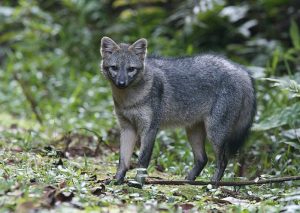Brazil is well-known for having Amazon rainforest that is a home for many wild animals and plants. Brazil is also considered as a country which has the greatest biodiversity of any country in the world. It has the most known 55,000 species of plants, 3,000 species of freshwater fish and over 689 species of mammals.
Living in the rainforest in Brazil, there are characteristics of animals in rainforest that make them different with any other animals living in the forest.
If you are curious of what animals are native to Brazil, then look at these 6 animals native to Brazil and you will get amazed.
- Short-eared Dog
This species of dog is commonly found in the tropical Amazon rainforest region in South America (covering Brazil, Peru, Bolivia, Colombia and Ecuador). The short-eared dog has short and slender limbs with rounded and short ears.

It has a fox like tail which is long and bushy and it is around 25 to 35 cm long. The size of an adult short-eared dog is around 72 to 100 cm long. This species of dog can live up to 11 years.
Uniquely, this short-eared dog is easily intimidated by humans and that’s why it tends to avoid humans in its natural environment. Short-eared dogs are commonly seen after sundown.
They are mostly solitary animals, but sometimes they hunt in pairs. Regarding to their diet, they are omnivores, consuming frogs, crabs, and wild fruits.
Unfortunately, the population of short-eared dogs is declining due to their natural habitat destruction.
- Hoary Fox
The hoary fox is native to South America. It has short muzzle, a short coat, slender limbs and small teeth. This hoary fox lives in the cerrado, which is a tropical savannah of Brazil, where bush lands, smooth and scattered savannahs with trees are available.
Hoary fox is a nocturnal animal, and mostly solitary outside the season of breeding. Besides hoary fox, there are some other nocturnal animals that are night hunters.
Regarding to their diet, they are classified as insectivorous, which means they eat insects. No wonder, they are given small teeth to eat grasshoppers and termites.
This hoary fox is considered as vulnerable animal in Brazil where no hunting for wildlife is allowed.
- Jaguarundi
Another native animal to Brazil is jaguarundi. This is a species of small wild cat native to Americas. It has medium-sized bod with slender build. An adult of jaguarundi can weigh as light as 6 pounds and as heavy as 20 pounds. There are 3 various colors of coat: red, brownish-grey and black.
Jaguarundi occupy a wide range of dry scrub, swamp, savannah woodland to primary forest. Jaguarundi is also known as solitary animal, but it can travel and forage in pairs. Regarding to their diet, they are mainly consuming small rodents, rabbits, quail, wild turkey, frogs and reptiles. They also consume fish stranded in puddles.
Jaguarundis are not exploited for trade, but they are caught by traps. Due to their notorious status of raiding domestic poultry, they are threatened by farmers because of it. Their natural habitat is also threatened by destruction.
You also can read South American wild cats to get to know other wild cats native to South America besides jaguarundi.
- Ocelot
Ocelot is a species of nocturnal cat. Ocelots are twice as big as the average house cat. Their size can reach 28 to 35 inches and they can weigh around 24 to 25 pounds. Unlike most cats, they do not avoid water and are good swimmers. Most ocelots live in South American rainforests but they also occupy brushlands.
Regarding to their diet, they are mostly consuming meat. Their pointed fangs are used to bite and kill the prey, while the sharp back teeth are designed to tear the food just like scissors.
Their population declines due to countless hunters of their fine fur. They are considered as protected animals in the United States and other countries where they inhabit.
- Golden Lion Tamarin
Lions are mostly living in African savannah, but Brazil also has another creature named golden lion tamarin. This is not lion, but it is a species of monkey. This monkey gets its beautiful name from the color of the fur, which are red, golden, and orange. The fur gives an appearance of a lion’s mane that’s why it is called golden lion tamarin. Golden lion tamarins weigh around 0.8 to 1.8 pounds.
Golden lion tamarin is a diurnal animal which means it is only active during the day and sleep at night. Though it is having small body, it has long tail that is really useful to balance and jump between the trees.
You can find this small monkey in the Atlantic forest of Brazil. This forest is located in the southeastern coast of Brazil, Argentina and Paraguay.
Deforestation is the main threat of golden lion tamarin’s population. Humans cut down trees and it leads to its declining population.
- Poison Dart Frog
As its name tells you, poison dart frog is poisonous and has secrete toxic lipophilic alkaloids through its skin. These alkaloids are used to protect them from predators. This poison dart frog is inhabiting tropical and subtropical regions, freshwater marshes and swamps.
You can also see other native animals in Colombia and you will find frog as one of the animals there!
If you want to know more about animals Brazil, you can also spend time reading slithering differences of snake islands in Brazil and Indonesia. Both countries have snake island, but they are very distinctive.
